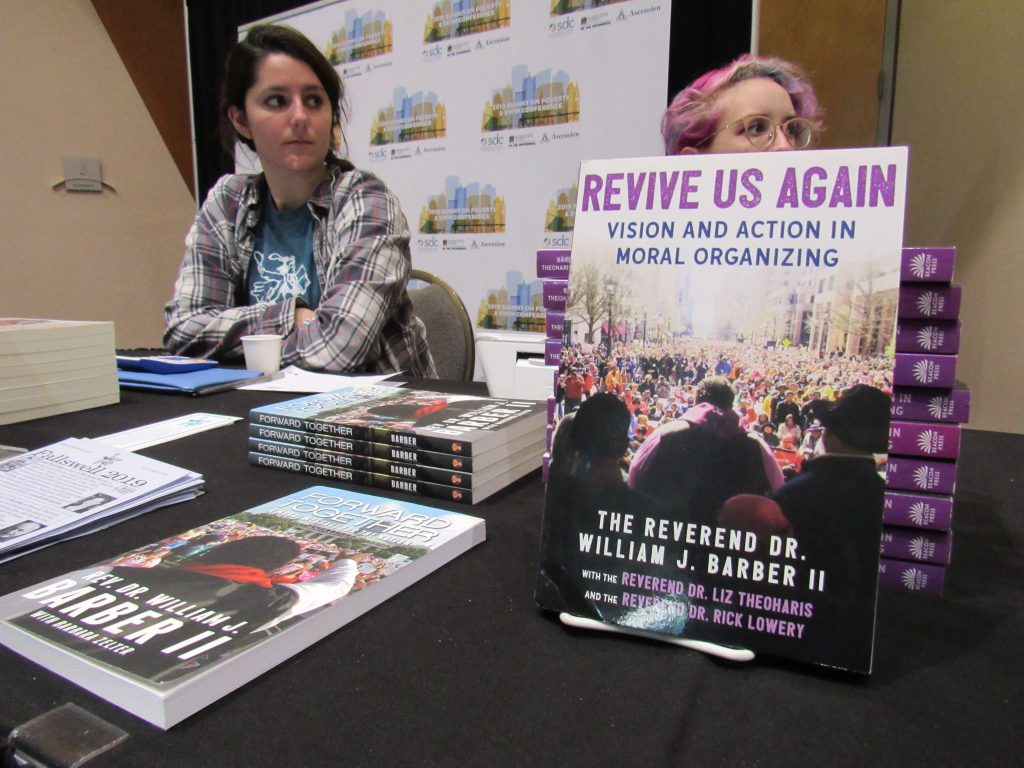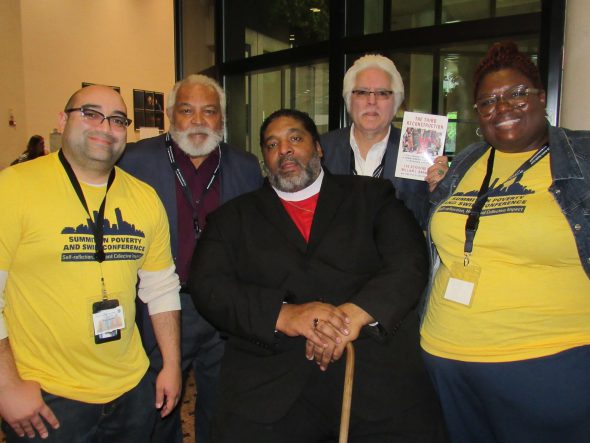The Power of Poor People’s Votes
Just a small increase in percent of low-income people who vote could transform elections in state and nation, report finds.

Books written by Rev. Barber and others were available at the Summit On Poverty Photo by: Isiah Holmes/Wisconsin Examiner.
America’s poor, over 140 million strong, have the power to shift the direction of this country. That’s according to a report compiled by the Poor People’s Campaign (PPC), examining how trends in American poverty translate to votes in the ballot box. The report’s title is a call to action “Unleashing the power of poor and low-income Americans, changing the political landscape.”
“We are building the political power and the moral vision to reconstruct America,” said Rev. Dr. Liz Theoharis, co-chair of the Poor People’s Campaign, and director of the Kiros Center. She declares that the new report, “proves empirically what we’ve always known. Poor and low-income people can become a transformative, new electorate.”
Theoharis and others from PPC presented the report via Facebook Live on August 11. A prerecorded video introduction included testimony from southern coal miners with black lung disease, disabled urban Americans and others. They shared tales of struggling in poverty, while feeling unheard by those in power. They described children watching as non-payment of utility bills led to the power in their entire neighborhoods being shut off. Mothers who lost their children expressed their grief. “All across the country, poor and low-income people are demanding accountable representation and trying to save the very soul of this democracy,” said Theoharis, the first to speak after the video ended.
Low-income people turn out to vote at a rate about 20 percentage points lower than higher income voters, according to the second of 10 key findings from the report. “The main reported reason for not voting is the same as other non-voters,” it notes. That is“lack of interest in the issues or feeling their vote will not matter.” According to the third key finding: “The issues that matter most to low-income people are health and economic well-being. Illness, disability and transportation have more of an impact on the ability of low-income people to vote.”
Robert Hartley, assistant professor of social work at Columbia University, and one of the report’s authors, feels the data reflects opportunities for mobilization. Describing a graph comparing voting trends of people with different incomes, he says, “It’s not that folks with low income are just not voting, and they’re not responsive. … they do respond to changes in the economy, changes in the candidates and issues.”
In 2016, according to the first key finding, 138 million people voted out of the 225 million who were eligible to do so. Some 29 million of these voters were poor and low-income people. Another 34 million poor and low-income eligible voters did not cast a ballot. Historically, poor and low-income voters have made up one-fifth or more of the average electorate for midterm elections from 2006-2018 across 15 states, the report found. “If the low-income population were to match the voting rates of higher income voters, then they would match or exceed the midterm election margins of victory in 16 states.” One of those states was Wisconsin, where low-income eligible voters who didn’t vote made up 11% of the overall electorate, Hartley noted.

Rev. William Barber (center) and Poverty Summit Director Abra Fortson (right). Photo by Isiah Holmes/Wisconsin Examiner.
All of that was before the pandemic. Many of the issues which unite poor and low-income voters across ethnic and religious lines have also been compounded by the pandemic of 2020. “The pandemic has shown us that poverty and racism are the fissures, are the wounds through which this pandemic has power,” said Rev. Dr. William Barber, who co-chairs the Poor People’s Campaign alongside Theoharis. “And now we’re headed towards 50% of Americans being poor or low wealth. Another 27 million people have lost their insurance, 30 million people who are unemployed and seeking unemployment.”
Barber asserts that while America’s poor were in a depression before COVID-19, the situation is evolving into “economic annihilation.” These issues aren’t just related with one another. They’re what Barber calls, “moral fusion issues,” experienced by the growing sector of poor and low-income Americans.
Going forward, the real question is how much of an impact this growing and disenfranchised sector will have on the elections. “Poor and low-income people are deciding ‘we must do more,’” said Barber. “We must mobilize, organize, register, and educate. We must vote in November, we must be engaged after November. Poor and low-income people are saying, ‘We are not going to be ignored anymore.’”
It’s a proud challenge which goes out to both the Trump Administration, and the Democratic Party. For Barber, a neo-liberal approach of focusing just on the middle class is no longer enough to both secure votes and protect the welfare of the people. For Barber and his colleagues at the Poor People’s Campaign, it’s not uncommon to hear from low-income Americans that they feel entirely forgotten by elected officials,hether they label themselves as Democrats or Republicans.
“Overall,” reads the PPC’s report, “states with potential changes include states with both Democrat and Republican outcomes, which underscores that this evidence is related to the potential for a more representative vote by income status, and perhaps to a call for increased campaign focus on issues that matter to low-income families.”
“Poverty does not have to exist,” said Barber. “It is not inevitable, it’s created by bad public policy.” The Poor People’s Campaign’s report peers into the untapped power of low-income voters to change policy. “Poor and low-wealth people have the power to expand and change the electorate,” emphasizes Barber. “This report shows that there were 34 million poor and low-income people who were eligible to vote in 2016 who did not vote. This means that poor and low-income people concentrate over 25% of the electorate.”
I
Lack of transportation, targeted shut-downs of polling stations, and other forms of legislative voter suppression add to the problem. During a recent protest on evictions in Milwaukee, protesters noted how the lack of a fixed address impedes one’s ability to vote. It’s something one might not have thought about before the economic stress of COVID-19 left people without a job or home.
The pandemic seems to provide another opportunity for voter suppression. During Wisconsin’s so-called “pandemic primary” election in April, thousands of residents in Madison and Milwaukee braved long lines. Social distancing was difficult, and people were still adjusting to how the virus changed ordinary life. Voting by mail with an absentee ballot might seem like a commonsense way around the problems of in-person pandemic voting. Nevertheless, the system has been attacked by the Trump Administration both through policy and rhetoric.
According to the Poor People’s Campaigns report, one-fourth of all cast votes were mailed in. “Voting by mail is increasingly common across personal characteristics and income status,” reads the fourth key finding of the report. “And has been strongly bipartisan in state implementation.” If low-income Americans participated at similar rates as their higher income peers, election results across 15 states could have been different four years ago. “This includes key battleground states and states in the South,” reads the ninth key finding of the Poor People’s Campaign report.
Theoharis said over the next three months, PPC will “intensify our work among poor and low-income voters, especially in states with key Senate races. We’re rolling out a campaign to expand our base, register millions of voters, and protect voting rights. As we in the Poor People’s Campaign say and sing, somebody’s been hurting our people. It’s gone on far too long, and we can’t and won’t be silent anymore. This report, and our movement that’s growing across this nation, shows just this.”
Reprinted with permission of Wisconsin Examiner.





















